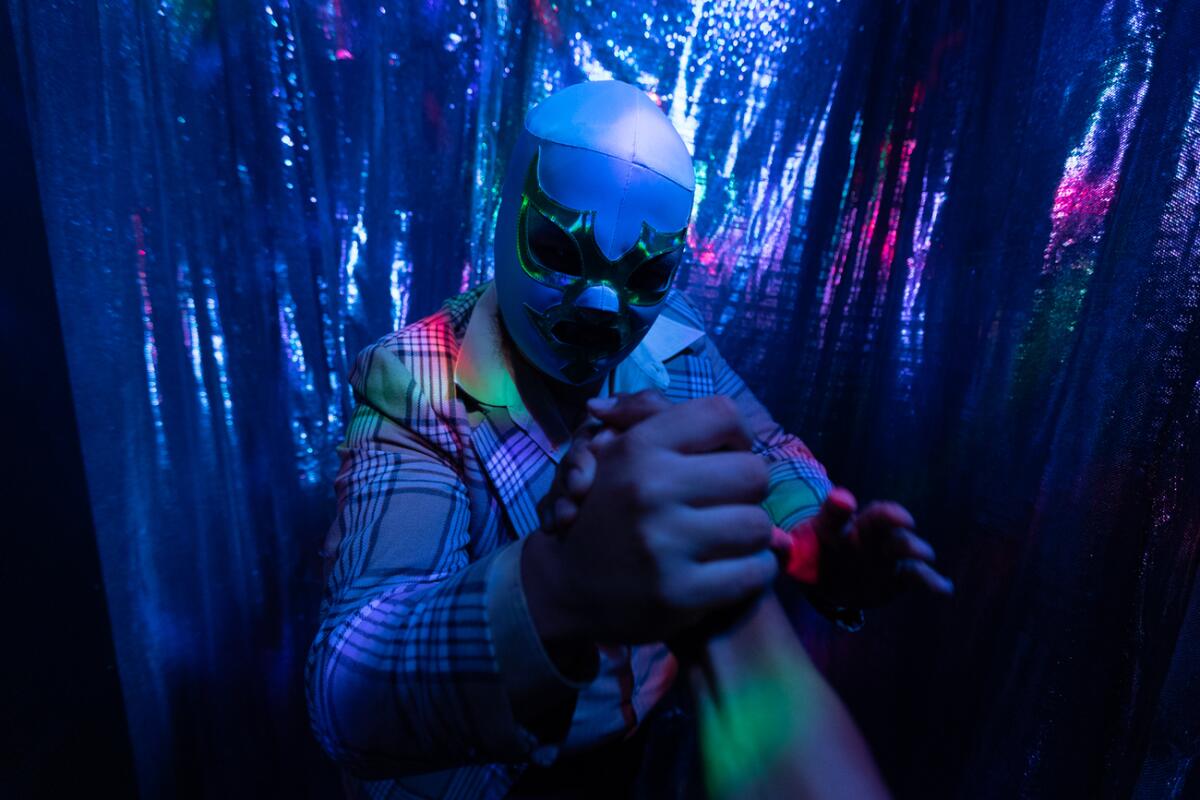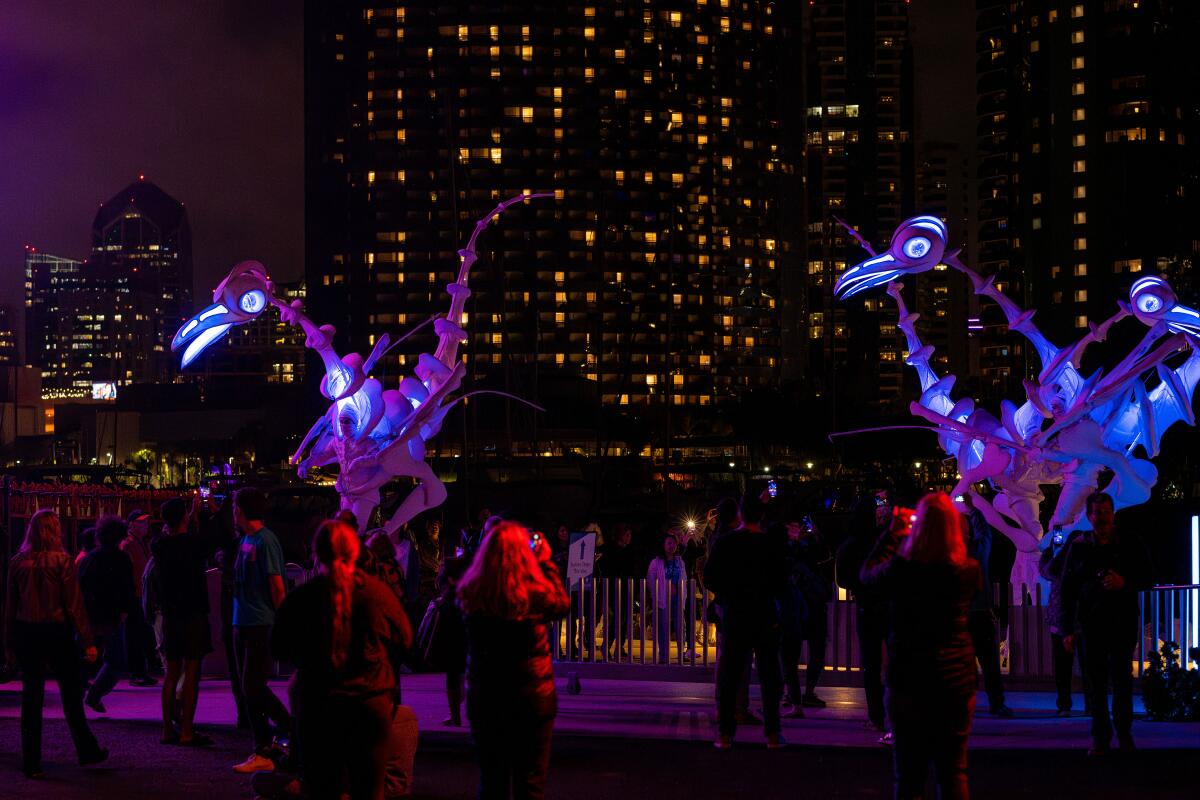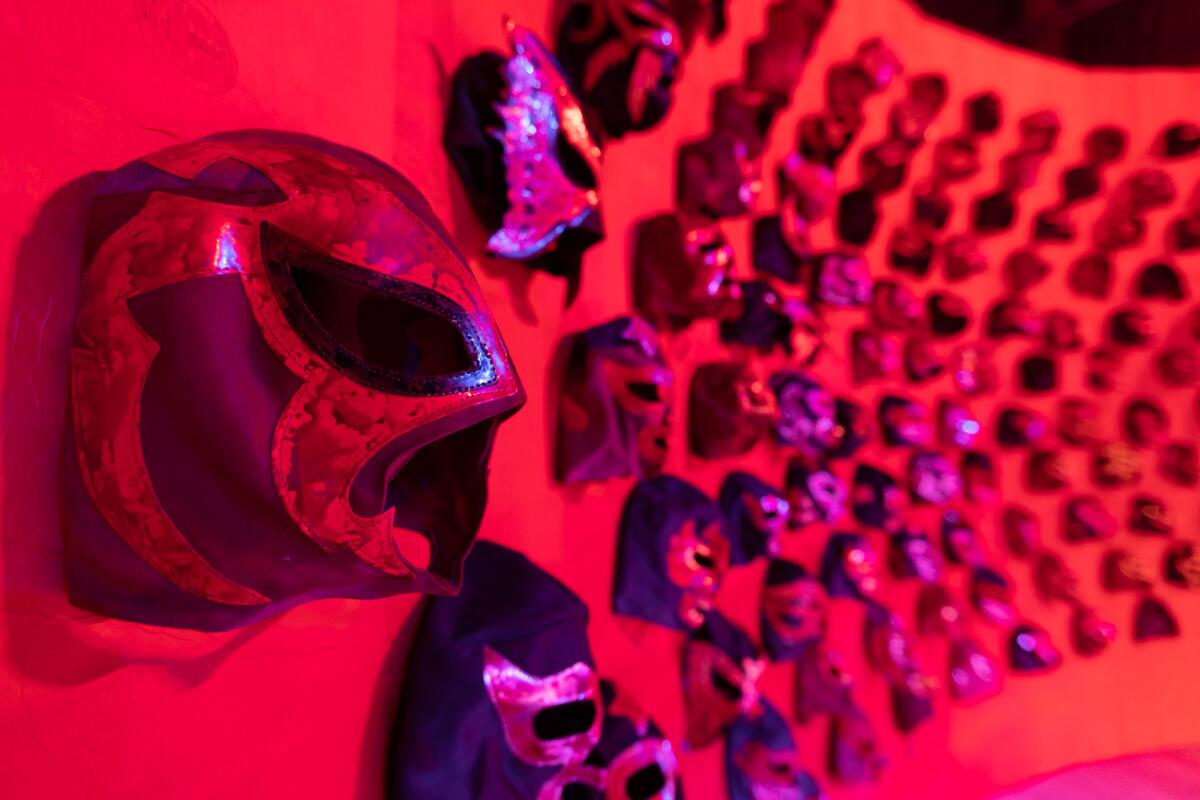La Jolla Playhouse’s immersive ‘La Lucha’ finds heartbreak and mystery in the world of lucha libre wrestling

- Share via
There’s ritual, flamboyance, larger-than-life characters and aerobatic maneuvers in the world of lucha libre wrestling. So I went into “La Lucha,” a new immersive, interactive theater production opening May 11 at the Museum of Contemporary Art San Diego, expecting mystery.
Wandering from room to room filled with floor-to-ceiling set pieces — from the side of a ring, to an intimate bedroom, to back alleyways and to bar stools, some of these scenes framed like a peep show — I encountered a personal production that felt like an elaborate puzzle.
As scenes built, the secrets of the story expanded, and a tragedy of death and romance gradually emerged. In the show’s opening moment, a screen of digital text introduced members of the audience to the cast and informed us that a wrestler had died in an accident. We met those whose lives were touched by the wrestler, and we slowly discovered that the drama focused on the complexities of the human heart, unmasking a world in which we see we’re all performers of a sort.
I danced and had shots with the actors and contemplated the ways in which my own recent heartbreak lives forever beneath the surface of my thoughts and actions.
Actors grabbed us by the hand and whisked us from scene to scene. In one moment, they appeared on the verge of a breakdown; in others, they attempted to place a bandage on the pain and act with exuberance. “La Lucha” in its 60 minutes takes on a metaphorical bent. The one major choreographed wrestling match felt hauntingly imaginary, as characters danced around a mat framed by colorfully painted masks that watched over us like memories seeking to torment.
“La Lucha” debuted this past weekend as part of La Jolla Playhouse’s yearly Without Walls Festival, this year in downtown San Diego, which celebrates the intermingling of theater and play.
Some of the performances were decidedly game-like. Ash Eliza Smith and Robert Twomey‘s “Cleaning the Stables” had guests don headphones as they tidied up parts of Jacobs Park, asking us to listen to and record thoughts as we explored the sinister ways in which gamification is overtaking our daily lives.
A revival of the jubilant “Brassroots District: Live in the Lot Summer ’73,” from Ari Herstand, Andrew Leib, Monica Miklas and Daysha Veronica, which ran in downtown L.A. in summer 2021, turned an outdoor courtyard into a participatory game of music industry high-jinks and communal dance.

The San Diego Symphony’s “A Shared Space” transformed our smartphones into musical instruments. A twist or a flick of the phone elicited digital beeps or snake-like rattles, filling the park’s Rady Shell with digital and symphonic sounds, turning strangers into a collective, even if the resulting composition were abstract and dissonant.
Close-Act Theatre’s “Birdmen” featured stilt-walking puppets of prehistoric creatures traversing the crowd and bringing the performance to the audience to ask us to re-imagine our environment. All the productions, even Monki • Tent’s up-close-and-personal dance “360” — in which attendees were placed on moving stools — sought to remake the relationship between audience and performer.
But the star this year was clearly the world premiere of “La Lucha,” from David I. Reynoso’s Optika Moderna and presented in collaboration with San Diego’s Museum of Contemporary Art, where it will run through June 4.
Reynoso previously explored coming-of-age traditions in “Las Quinceañeras” and collaborated with London’s immersive theater company Punchdunk on New York’s “Sleep No More” and other productions.
Here, he employs similar tracks to past performances, such as giving audience members headphones and visor-like headsets to shorten — or completely block — their view. The effect was disorienting at first, but “La Lucha” aimed to transport us — the headphones providing abstract audio and folkloric balladeering, all of it creating a dreamy sensation. The headsets also trained audience members to keep their focus on the movements of the actors.
With multiple performances throughout the hour, “La Lucha” uses a revolving cast, and the actors are asked to be versatile. At one disconcerting moment, my visor was covered and my hands were placed on a rope, which was used to guide me deeper into the various realms of heartbreak explored by the show. This was a theme park trick, in which I was moved along a sort of track — in this case a rope — awaiting a reveal.
The set design, regardless of the room, felt dark and melancholic, a world of candlelight and muted lighting. The latter, I think, led to me mixing up some of the masked characters, but I didn’t necessarily view this as a flaw of the show; Reynoso and team are after emotional touch-points rather than plot-driven ones. The larger ideas in this essentially wordless show — there is one striking musical number — regarding personal trauma and family rise to the top.

Framed as a mystery of one wrestler’s death, “La Lucha” ultimately is interested only in private drama, showing us characters struggling to move on, even when their desire to persevere is urging them forward. And high points — a wedding dance, for instance — soon become laced with deeper meaning. We know the marriage with the wrestler will end in tragedy, but we also start to grapple with deeper, more complex issues: Was the union a desired one, for instance, and what role did family or cultural traditions have on such an act of domestic harmony? Different audience members will follow different characters at various points in the maze-like rooms, unlocking more secrets while keeping others just out of reach.
“La Lucha” is also a show that’s difficult to spoil. As with the most experimental of immersive theater, it invites discussion, asking audience members to piece together the various branching narratives — I, for instance, was most often placed with the widow, whereas my companions were trailing other cast members. That’s why I was left with images rather than story points. Some continue to ask of me deeper contemplation, leaving me to analyze my own struggle to move on while also not wanting to forever feel the scars of heartbreak. An underlying surrealness — bodies soar among the ceiling in one scene — is an invitation to curiosity while reflecting the strange nightmare that is perpetual grief.
One circular room, for instance, felt downright haunting. The actor guiding me around the room trained my face at the walls, which were outfitted with hundreds of lucha libre masks. The visor I was wearing tightly cropped my field of vision, and as we walked in a circle, it was a purposefully dizzying display. As the characters before us would soon do battle with inner demons, the wall felt alive. I interpreted each mask as belonging to a lived experience, a moment in a life. Each one of us, they seemed to be saying, is acting through our existence.
Each scene was intimate, with rarely more than three of four people in a room at a time. The best immersive theater gradually turns audience members into participants, allowing actors to graft their stories onto us.
The power of “La Lucha,” however, is that it’s constantly looking inward, asking those in the audience to think about its topics rather than simply perform actions or decipher its subplots. And while I’m far from versed in lucha libre lore — and would love to revisit the show with someone who is — the themes of heartache and miscommunication are universal.
‘La Lucha’
More to Read
The biggest entertainment stories
Get our big stories about Hollywood, film, television, music, arts, culture and more right in your inbox as soon as they publish.
You may occasionally receive promotional content from the Los Angeles Times.











